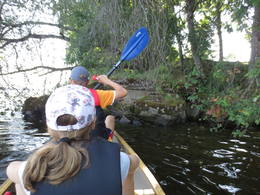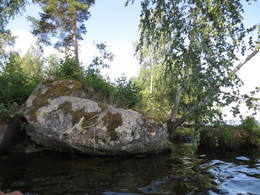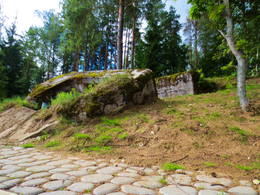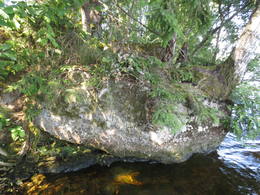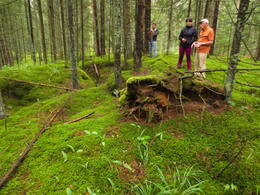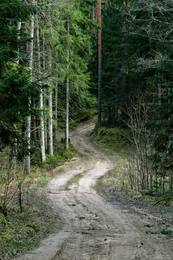Усилия жителей Кегумской стороны по спасению электростанции
22 июня 1941 года (воскресенье) в Латвии начались события Второй мировой войны. Волна войны «настигает» Кегумс без особого боя. Когда советская армия поспешно отступала, русские солдаты носились вокруг загородного дома Томе в поисках еды.
Чтобы защитить население, мы создали группу безопасности с контактным лицом в штаб-квартире Томе. Алдерманис, сотрудник электростанции из дома Штутена, и техник по просьбе директора г-на Красовской помогли нам предотвратить запланированный взрыв электростанции.
Управление безопасности России запросило у директора П. Красовскиса план электростанции и человека, который мог бы показать им достопримечательности. Если в туннеле размещены ящики с динамитом, должна быть возможность войти и перерезать подключенные провода. Действуем быстро и осторожно, используя для наблюдения чердак хутора Бики.
Солдатам, одетым в российскую форму, разрешают переходить мост, а рядовых задерживают до проверки документов.
«Добыв» обмундирование четырех российских солдат, сотрудники нашей электростанции проникают в большую группу россиян, перешедших мост.
Техник, как административное лицо со специальным разрешением, имел возможность поговорить с охраной моста. Как и планировалось, нас встретил техник, и им удалось пробраться в шахту и перерезать провода. На второй день пришел техник с благодарностью от господина Красовского за проделанную работу. Наши корреспонденты предупредили, что на командном пункте установлено взрывное устройство, что свидетельствует о повреждении проводов. Мы видели, обнаружат ли российские бомбардировщики повреждения и поднимут тревогу. События ускорились. Воинские части мостовой охраны были заменены полицейскими караулами в частной одежде (с надписью на рукаве). Были беспорядки, а с появлением на дорогах нескольких немецких бронемашин электростанция осталась без охраны. По предложению техника мы взяли на себя охрану в качестве добровольцев, и наши люди несколько дней охраняли Кегумс. Приехал г-н Красовский со своим штабом, подъехал немецкий бронеавтомобиль, его командир коротко поговорил с руководством и уехал.
Немецкое политическое руководство и глава Рижского уезда Вейда прибыли из Риги. Он лично поблагодарил меня и охранников Тома за патриотическую работу. Мы получили зарплату, первые немецкие деньги в Латвии и призыв служить в полицию.
Теперь, спустя десятилетия, я осознал опасность Кегумса и огромные усилия директора Красовского по спасению нашей электростанции.
Однако в июне при отступлении частей Красной Армии на 80-метровый 6-й прогон Кегумского моста была сброшена бомба, чтобы хоть как-то помешать гитлеровской армии двигаться на восток. Электростанция продолжала работать в обычном режиме. Мост был восстановлен в деревянной конструкции в течение двух месяцев.
Затем повреждения были устранены группой строителей под моим контролем, соорудили лестницу и мост через взорванный участок, чтобы можно было продолжить работы. Позже был построен подвесной мост, потому что нужно было привезти щебень для бетонирования из Бирзгале. По этому мосту можно было передвигать одну тележку. Было много работы.
Андерсон Р. 2004. Кегумская гидроэлектростанция. П.
Связанная хронология
Связанные объекты
Бетонная огневая точка немецкой армии в водохранилище Кегумской ГЭС у устья Нега
Он расположен в водохранилище Кегумской ГЭС в устье Неги (перед домами Неги), на его левом берегу. Один из самых визуально и живописно впечатляющих, а также наиболее хорошо сохранившихся бетонных каминов, омываемых волнами Даугавы. Это видно из более крупного куска. С берега на вершину огневой точки (заросшей травой) сооружен пешеходный мост. Узкоколейные (?) железнодорожные пути, заделанные в бетонные стены пожарной части. Попасть внутрь можно со стороны пешеходного моста. Это одна из огневых точек линии обороны немецкой армии в годы Первой мировой войны на левом берегу Даугавы, которая более или менее прослеживается на всем протяжении левого берега Даугавы. Вышеупомянутая линия обороны представляет собой масштабную военную систему, которая до сих пор толком не оценивалась в целом. Остатки пожарной точки можно увидеть на лодке на Кегумской ГЭС.
Бетонная огневая точка немецкой армии на вершине берега Кегумской ГЭС перед Андулием
Он расположен примерно в 1,2 км к востоку от небольшого продолжения ручья (ручей впадает в Леясгрантинини) на вершине крутого склона берега Кегумской ГЭС перед Андулием. Берег в этом месте зарос лесом и подлеском, поэтому со стороны водоема эту огневую точку заметит только внимательный наблюдатель. Огненная точка хорошо сохранилась, так как не пострадала от береговой эрозии. Это одна из огневых точек линии обороны немецкой армии в годы Первой мировой войны на левом берегу Даугавы, которая более или менее прослеживается на всем протяжении левого берега Даугавы. Вышеупомянутая линия обороны представляет собой масштабную военную систему, которая до сих пор толком не оценивалась в целом. На Кегумской ГЭС пожарную точку можно увидеть с лодки, так как она находится на частной территории.
Остатки бетонной огневой точки немецкой армии в водохранилище Кегумской ГЭС перед Сидрабини
Он расположен примерно в 0,25 км к востоку от залива водохранилища Кегумской ГЭС недалеко от Силапупежи, в направлении Яунелгавы, напротив хутора Сидрабини. Точка возгорания частично соскользнула в воду и раскололась на несколько частей, напоминая груду строительного мусора. Берега заросли. Это одна из огневых точек линии обороны немецкой армии в годы Первой мировой войны на левом берегу Даугавы, которая более или менее прослеживается на всем протяжении левого берега Даугавы. Вышеупомянутая линия обороны представляет собой масштабную военную систему, которая до сих пор толком не оценивалась в целом. Остатки пожарной точки можно увидеть на лодке на Кегумской ГЭС. Примерно в 150 м к западу от берега Даугавы в воду сошли остатки еще одной огневой точки.
Остатки бетонной огневой точки немецкой армии в водохранилище Кегумской ГЭС перед Яундауглием
Он расположен на берегу водохранилища Кегумской ГЭС примерно в 0,6 км восточнее устья Нега, напротив Яундауглия. Острие огня соскользнуло с берега в воду и раскололось на несколько частей. В нем выросли две большие березы, выросла чаща. Одна его часть соединена с берегом пешеходным мостом. Это одна из огневых точек линии обороны немецкой армии в годы Первой мировой войны на левом берегу Даугавы, которая более или менее прослеживается на всем протяжении левого берега Даугавы. Вышеупомянутая линия обороны представляет собой масштабную военную систему, которая до сих пор толком не оценивалась в целом. Остатки пожарной точки можно увидеть на лодке на Кегумской ГЭС.
Бетонная огневая точка немецкой армии на берегу Кегумской ГЭС у Пудурие
Он расположен на полуострове в устье Конупите (ныне затопленное продолжение реки) в Даугаве, на территории комплекса отдыха «Пудури». В результате волновой эрозии очаг возгорания наклонился в сторону реки. Для предотвращения береговой эрозии берега водохранилища здесь укреплены бетонной защитной стеной. Огневые точки линии обороны немецкой армии в годы Первой мировой войны более или менее прослеживаются на всем протяжении левого берега Даугавы. Вышеупомянутая линия обороны представляет собой масштабную военную систему, которая до сих пор толком не оценивалась в целом. Точку огня хорошо видно, если проплыть на лодке вдоль Кегумской ГЭС.
Остатки бетонной огневой точки немецкой армии на берегу водохранилища Кегумской ГЭС перед Силапупежи
Он расположен примерно в 0,1 км к востоку от залива водохранилища Кегумской ГЭС недалеко от Силапупежи, в направлении Яунелгавы. Огневая точка частично сползла в воду, заросла деревьями, кустами и прочей растительностью, и непосвященному больший кусок со стороны воды может напоминать более крупный камень. Одна из достопримечательностей – растущая на нем береза. Это одна из огневых точек линии обороны немецкой армии в годы Первой мировой войны на левом берегу Даугавы, которая более или менее прослеживается на всем протяжении левого берега Даугавы. Вышеупомянутая линия обороны представляет собой масштабную военную систему, которая до сих пор толком не оценивалась в целом. Остатки пожарной точки можно увидеть на лодке на Кегумской ГЭС. Примерно в 150 м к востоку от берега Даугавы в воду сошли остатки еще одной огневой точки.
Возможное местонахождение бункера Отомарас Ошкалнс
Удаленное и труднодоступное место - большой лесной массив примерно в 200 м к западу от р. Неги и примерно в 0,5 км к юго-западу от поймы Неги. До указанного места рекомендуется дойти пешком или на велосипеде, используя карты LIDAR и географические координаты. В указанном месте имеется внутренняя дюнная насыпь длиной около километра (в направлении З-В) и шириной около полукилометра (в направлении С-Ю), покрытая хвойным лесом. На вершине северного и восточного склонов массива дюн находятся хорошо сохранившиеся траншеи, предположительно времен Второй мировой войны. Харийс Яунземс (бывший инженер Кегумской ГЭС) считает, что в этом районе находился бункер партизанского отряда Красной Армии, сформированный Отомарасом Ошкалнсом (точное место неизвестно).
Принц Леопольд Штрассе (Prinz – Leopold Straße)
Название места (дороги) во время Первой мировой войны — «Prinz — Leopold Straße» — дорога принца Леопольда. Историческая лесная дорога длиной около 7 км или место, которое начинается на стыке Гроссе Курфюрстен Дамм и Кайзер Дамм возле так называемого Курляндского Денкмаля и извивается через лес в сторону Бирзгале, соединяясь с узкоколейной железной дорогой времен Первой мировой войны: Лачплесис – Латгали. К западу от дороги и примерно в 2 км к югу от Курляндии Денкмаль находится полигон времен Первой мировой войны. Сегодня по дороге принца Леопольда можно ходить пешком, ездить на велосипеде и водить машину (при подходящих условиях). Дорога пересекает Конупити и приток Нега.
Считается, что солдаты немецкой армии, долгое время стоявшие на переднем крае левого берега Даугавы, назвали эту дорогу в честь баварского принца Леопольда (1846 - 1930), возглавлявшего германские и австро-венгерские войска. на Восточном фронте в годы Первой мировой войны.







